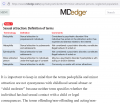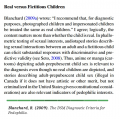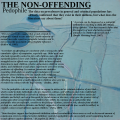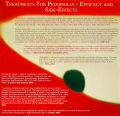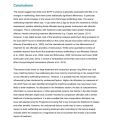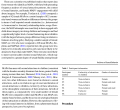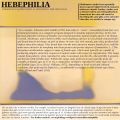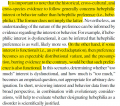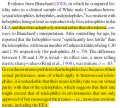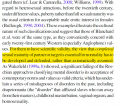Research: Pedophilia as a sexual/erotic orientation: Difference between revisions
The Admins (talk | contribs) |
No edit summary |
||
| (10 intermediate revisions by 4 users not shown) | |||
| Line 1: | Line 1: | ||
{{research}}__NOTOC__ | {{research}}__NOTOC__ | ||
If Heterosexuality and Homosexuality are erotic gender orientations, Pedophilia is an erotic age orientation. The American | If Heterosexuality and Homosexuality are erotic gender orientations, [[Pedophilia]] is an erotic age orientation. The American Psychiatric Association's DSM-5, popularly referred to as the "bible of psychiatry", now describes pedophilia as a sexual orientation or interest that does not necessarily constitute a disorder. Mainstream researchers - "big beasts" of sexology such as Seto, Berlin, Bailey, Blanchard, Finkelhor and Cantor all support this position, and are open about it with the media.<ref>[https://www.vice.com/en/article/mgmzwn/most-child-sex-abusers-are-not-pedophiles-expert-says Vice.com (2016) - Most Child Sex Abusers Are Not Pedophiles, Expert Says]</ref><ref>[https://reason.com/2016/08/24/beyond-gay-straight-sexual-orientation/ Reason (2016) - Beyond Gay and Straight: New Paper Says Sexual Orientation Is Much More Complicated]</ref> [[Hebephilia]] has been rejected as a paraphilia, as our article points out. In general, pedophiles and hebephiles are ''less'' exclusive in their attractions than [[Teleiophilia|teleiophiles]].<ref>[https://link.springer.com/article/10.1007/s10508-010-9675-3 Blanchard, R., Kuban, M.E., Blak, T. et al. Sexual Attraction to Others: A Comparison of Two Models of Alloerotic Responding in Men. Arch Sex Behav 41, 13–29 (2012).]</ref> | ||
*'''Seto, Michael (2012). [https://end-the-stigma.com/resources/Is_Pedophilia_a_Sexual_Orientation-Michael_C_Seto.pdf "Is Pedophilia a Sexual Orientation?"], ''Archives of Sexual Behaviour'', 41, p. 233.''' | *'''Seto, Michael (2012). [https://end-the-stigma.com/resources/Is_Pedophilia_a_Sexual_Orientation-Michael_C_Seto.pdf "Is Pedophilia a Sexual Orientation?"], ''Archives of Sexual Behaviour'', 41, p. 233.''' | ||
| Line 17: | Line 17: | ||
*:"Pedophilia is a sexual orientation and unlikely to change. Treatment aims to enable someone to resist acting on his sexual urges." | *:"Pedophilia is a sexual orientation and unlikely to change. Treatment aims to enable someone to resist acting on his sexual urges." | ||
*'''Gaither, George A. (2002). "[https://sci-hub.se/10.1023/A:1020603214218 Peer Commentaries on Green (2002) and Schmidt (2002): Pedophilia as a Sexual Orientation?]," ''Archives of Sexual Behavior'', 31(6), 486. DOI:[https://doi.org/10.1023/A:1020603214218 10.1023/A:1020603214218]''' | *'''Gaither, George A. (2002). "[https://sci-hub.se/10.1023/A:1020603214218 Peer Commentaries on Green (2002) and [[Gunter_Schmidt|Schmidt]] (2002): Pedophilia as a Sexual Orientation?]," ''Archives of Sexual Behavior'', 31(6), 486. DOI:[https://doi.org/10.1023/A:1020603214218 10.1023/A:1020603214218]''' | ||
*:"One possible conceptualization of pedophilia is that it is a sexual orientation. This point of view appears to be consistent with Schmidt's reasoning. Although most researchers have tended to discuss sexual orientation in terms of the sexes or gender identities of the individuals involved (most likely assuming that the individual to whom one is attracted is of consenting age), there have been a growing number of researchers who have defined sexual orientation in much broader terms, which include pedophilia (e.g., Barbaree, Bogaert, & Seto, 1995; Berlin, 2000; Feierman, 1990; Laws & O'Donohue, 1997; Suppe, 1984). Barbaree et al. (1995), for instance, stated that "sexual orientation is defined by (1) the ability of a certain class of stimuli to evoke sexual arousal and desire in the individual, (2) the persons or objects toward which sexual behavior and activity are directed by the individual, and (3) the persons or objects depicted in fantasies and cognitions" (p. 358). Pedophilia certainly fits within this definition of sexual orientation. Furthermore, clinical evidence suggests that, similar to homosexual or heterosexual orientations, a pedophilic sexual orientation typically begins by early adolescence, tends to be lifelong, and is resistant to change (Abel & Osborn, 1995; Marshall, 1997), for as Schmidt states, it is part of the person's identity." | *:"One possible conceptualization of pedophilia is that it is a sexual orientation. This point of view appears to be consistent with [[Gunter_Schmidt|Schmidt's]] reasoning. Although most researchers have tended to discuss sexual orientation in terms of the sexes or gender identities of the individuals involved (most likely assuming that the individual to whom one is attracted is of consenting age), there have been a growing number of researchers who have defined sexual orientation in much broader terms, which include pedophilia (e.g., Barbaree, Bogaert, & Seto, 1995; Berlin, 2000; Feierman, 1990; Laws & O'Donohue, 1997; Suppe, 1984). Barbaree et al. (1995), for instance, stated that "sexual orientation is defined by (1) the ability of a certain class of stimuli to evoke sexual arousal and desire in the individual, (2) the persons or objects toward which sexual behavior and activity are directed by the individual, and (3) the persons or objects depicted in fantasies and cognitions" (p. 358). Pedophilia certainly fits within this definition of sexual orientation. Furthermore, clinical evidence suggests that, similar to homosexual or heterosexual orientations, a pedophilic sexual orientation typically begins by early adolescence, tends to be lifelong, and is resistant to change (Abel & Osborn, 1995; Marshall, 1997), for as [[Gunter_Schmidt|Schmidt]] states, it is part of the person's identity." | ||
*'''[[Ray Blanchard|Blanchard, Ray]]; Kolla, Nathan J.; [[James Cantor|Cantor, James M.]]; Klassen, Philip E.; Dickey, Robert; Kuban, Michael E.; and Blak, Thomas (2007). "IQ, Handedness, and Pedophilia in Adult Male Patients Stratified by Referral Source," ''Sexual Abuse: A Journal of Research and Treatment'', 19(3), 285-309.''' | *'''[[Ray Blanchard|Blanchard, Ray]]; Kolla, Nathan J.; [[James Cantor|Cantor, James M.]]; Klassen, Philip E.; Dickey, Robert; Kuban, Michael E.; and Blak, Thomas (2007). "IQ, Handedness, and Pedophilia in Adult Male Patients Stratified by Referral Source," ''Sexual Abuse: A Journal of Research and Treatment'', 19(3), 285-309.''' | ||
| Line 29: | Line 29: | ||
*:"Pedophiles are men who are more sexually aroused by children than they are by adults of either sex. That is, their sexual orientation is toward children." | *:"Pedophiles are men who are more sexually aroused by children than they are by adults of either sex. That is, their sexual orientation is toward children." | ||
*'''Martijn, | *'''Martijn, Frederica et al. (May 2020). [https://sci-hub.st/https://link.springer.com/article/10.1007/s10508-019-01579-9 Sexual Attraction and Falling in Love in Persons with Pedohebephilia], ''Archives of Sexual Behavior'' 49(2), pages 1305–1318'''. | ||
*: | *:Few studies of pedophilia or hebephilia have included questions about romantic attraction. We conducted an anonymous online survey of 306 men who self-reported as sexually attracted to children. The majority (72%) of participants reported they had fallen in love with a child in their lifetime. Participants reported greater feelings of attachment to children than feelings of infatuation. Though sexual attraction and falling in love were strongly correlated, they were not synonymous. Participants who reported pedohebephilia (defined in this study as attraction to prepubescent and pubescent children) were more likely to have fallen in love with a child than participants who reported pedohebe-ephebophilia (defined as attraction to prepubescent, pubescent, and post-pubescent minors). Also, participants with an exclusive attraction to children were more likely to have fallen in love with a child than participants who were equally attracted to children and adults. The results of this study were consistent with the suggestion of Seto (2012) that pedohebephilia could be considered a form of sexual orientation for age, which includes both sexual and romantic attraction. | ||
*'''Alanko K, Salo B, Mokros A, Santtila P, (2013). [https://www.researchgate.net/publication/235369954_Evidence_for_Heritability_of_Adult_Men's_Sexual_Interest_in_Youth_under_Age_16_from_a_Population-Based_Extended_Twin_Design "Evidence for heritability of adult men's sexual interest in youth under age 16 from a population-based extended twin design."] ''J Sex Med,'' 10(4):1090-9.''' | *'''Alanko K, Salo B, Mokros A, Santtila P, (2013). [https://www.researchgate.net/publication/235369954_Evidence_for_Heritability_of_Adult_Men's_Sexual_Interest_in_Youth_under_Age_16_from_a_Population-Based_Extended_Twin_Design "Evidence for heritability of adult men's sexual interest in youth under age 16 from a population-based extended twin design."] ''J Sex Med,'' 10(4):1090-9.''' | ||
*:"Sexual interest in children resembles sexual gender orientation in terms of early onset and stability across the life span. Although a genetic component to sexual interest in children seems possible, no research has addressed this question to date. Prior research showing familial transmission of pedophilia remains inconclusive about shared environmental or genetic factors. Studies from the domains of sexual orientation and sexually problematic behavior among children pointed toward genetic components. Adult men's sexual interest in youthfulness‐related cues may be genetically influenced." | *:"Sexual interest in children resembles sexual gender orientation in terms of early onset and stability across the life span. Although a genetic component to sexual interest in children seems possible, no research has addressed this question to date. Prior research showing familial transmission of pedophilia remains inconclusive about shared environmental or genetic factors. Studies from the domains of sexual orientation and sexually problematic behavior among children pointed toward genetic components. Adult men's sexual interest in youthfulness‐related cues may be genetically influenced. [...] The amount of variance attributable to nonadditive genetic influences (heritability) was estimated at 14.6%.[...] Compared with the variance attributable to nonshared environmental effects (plus measurement error), the contribution of any genetic factors seems comparatively weak." | ||
*:'''Editor''': Note, that a heritability coefficient close to zero does not mean the weakness/absence of genetic control over trait, counter wise may point to high genetic consistency among population, in which case trait variance would naturally be more dependent on the environment. ("Traits such as walking and breathing have low heritability, because these are usually universal traits with slight variations. [...] as heredity becomes more similar, the environment becomes the primary explanation for differences."<ref>[https://www.studysmarter.co.uk/explanations/psychology/biological-bases-of-behavior/heritability/ Studysmarter.co.uk: Explanation on heritability]</ref>) This finding of low heritability may be interpreted to mean that the genetic ability to develop minor attraction is highly pervasive among humans and modified by nurture and other environments. This goes along with the [[Research:_Evolutionary_Perspectives_on_Intergenerational_Sexuality#Mentorship-Bonding%2FEnculturation-Alliance_Hypothesis|Rind's conclusion]] on pederasty as evolutionary determined but a facultative trait. | |||
*'''Chenier, E. (2011). [https://sci-hub.se/10.1007/s12119-011-9116-z "The Natural Order of Disorder: Pedophilia, Stranger Danger and the Normalising Family"], ''Sexuality & Culture'', 16:172–18.''' | *'''Chenier, E. (2011). [https://sci-hub.se/10.1007/s12119-011-9116-z "The Natural Order of Disorder: Pedophilia, Stranger Danger and the Normalising Family"], ''Sexuality & Culture'', 16:172–18.''' | ||
| Line 51: | Line 52: | ||
Research on this topic is sparse, however '''female''' self-identifying exclusive and nonexclusive pedophiles have been studied in the literature. Lievesley and Lapworth (2021) interviewed a small sample of [[Intergenerational Lesbianism|Lesbian MAPs]], who tended to be nonexclusive in their attraction to minors.<ref>[https://link.springer.com/content/pdf/10.1007/s10508-021-02160-z.pdf Lievesley, R., Lapworth, R. “We Do Exist”: The Experiences of Women Living with a Sexual Interest in Minors. Arch Sex Behav (2021)]</ref> A considerable minority of women in one nonclinical sample had some form of sexual interest in children.<ref>[https://www.smoa.jsexmed.org/article/S2050-1161(20)30021-0/fulltext Sexual Interest in Children Among Women in Two Nonclinical and Nonrepresentative Online Samples]</ref> Further, a recent informal investigation has identified many '''trans and non-binary''' people within the broader population of self-identifying MAPs - possibly as many as 7%.<ref>[https://www.blockedandreported.org/p/because-god-hates-us-or-is-dead-heres-90c#details Podcast - Herzog/Singal] and [https://web.archive.org/web/20220319054813/https://barpodcast.fireside.fm/80 archive]</ref> | Research on this topic is sparse, however '''female''' self-identifying exclusive and nonexclusive pedophiles have been studied in the literature. Lievesley and Lapworth (2021) interviewed a small sample of [[Intergenerational Lesbianism|Lesbian MAPs]], who tended to be nonexclusive in their attraction to minors.<ref>[https://link.springer.com/content/pdf/10.1007/s10508-021-02160-z.pdf Lievesley, R., Lapworth, R. “We Do Exist”: The Experiences of Women Living with a Sexual Interest in Minors. Arch Sex Behav (2021)]</ref> A considerable minority of women in one nonclinical sample had some form of sexual interest in children.<ref>[https://www.smoa.jsexmed.org/article/S2050-1161(20)30021-0/fulltext Sexual Interest in Children Among Women in Two Nonclinical and Nonrepresentative Online Samples]</ref> Further, a recent informal investigation has identified many '''trans and non-binary''' people within the broader population of self-identifying MAPs - possibly as many as 7%.<ref>[https://www.blockedandreported.org/p/because-god-hates-us-or-is-dead-heres-90c#details Podcast - Herzog/Singal] and [https://web.archive.org/web/20220319054813/https://barpodcast.fireside.fm/80 archive]</ref> | ||
==Stigma against MAPs== | |||
An increasing number of writers have attempted to document the dangers of stigma against people with an attraction to minors, suggesting that negative attitudes may increase the risk of suicide and offending. We cover this in a [[Research: The Dangers of Stigma|separate page]]. | |||
==Excerpt Graphic Library== | ==Excerpt Graphic Library== | ||
Revision as of 23:14, 1 September 2024
 | ||||||||||||
| Part of NewgonWiki's research project | ||||||||||||
|---|---|---|---|---|---|---|---|---|---|---|---|---|
|
| ||||||||||||
| ||||||||||||
|
| ||||||||||||
| Template: Research - This template |
If Heterosexuality and Homosexuality are erotic gender orientations, Pedophilia is an erotic age orientation. The American Psychiatric Association's DSM-5, popularly referred to as the "bible of psychiatry", now describes pedophilia as a sexual orientation or interest that does not necessarily constitute a disorder. Mainstream researchers - "big beasts" of sexology such as Seto, Berlin, Bailey, Blanchard, Finkelhor and Cantor all support this position, and are open about it with the media.[1][2] Hebephilia has been rejected as a paraphilia, as our article points out. In general, pedophiles and hebephiles are less exclusive in their attractions than teleiophiles.[3]
- Seto, Michael (2012). "Is Pedophilia a Sexual Orientation?", Archives of Sexual Behaviour, 41, p. 233.
- "By the above definition of sexual orientation — and most common definitions of sexual orientation — pedophilia can be viewed as a sexual age orientation based on the more limited evidence available regarding its age of onset, associations with sexual and romantic behavior, and stability over time."
- Mundy, C. (2022). "10 years later: Revisiting Seto’s (2012) conceptualization of orientation to sexual maturity among pedohebephilic persons" (Project - University of British Columbia - Okanagan)
- "This study collected both quan titative and qualitative data from individuals with self-identified pedohebephilic attractions (n = 116). Several analyses were used to assess whether the sample characteristics followed Seto’s (2012) conceptual outline of pedophilia as an orientation to sexual maturity. The three developmental characteristics of gender-based sexual orientation were explored using survey and interview data. Overlap ping patterns with relation to the age of onset, expressions of both sexual and romantic attractions, and stability of such attraction over time were found. As noted by researchers and clinicians in this area, there are clear clinical implications associated with a shift in the conceptualization of sexual attraction to children. Such etiological conceptualizations are often poorly understood and/or conflated with sociocultural understandings and reactions. Despite resistance to such conceptualizations, the findings indicate that orientation to sexual maturity closely mirrors the developmental trajectory of gender sexual orientation, as outlined in Seto’s seminal paper."
- Mundy, C. (2022). "10 years later: Revisiting Seto’s (2012) conceptualization of orientation to sexual maturity among pedohebephilic persons" (Project - University of British Columbia - Okanagan)
- Cash, Brian. (2016). "Self-identifications, sexual development and well-being in minor-attracted people: an exploratory study", Thesis Presented to the Faculty of the Graduate School of Cornell.
- "Results indicate that minor-attracted people have varied experiences, but common themes that emerged in these areas are discussed. Regarding wellbeing, minor-attracted people in general had higher loneliness and lower self-esteem than the general public. But positive disclosure experiences and having some level of attraction towards adults were related to lower loneliness, and more accepting attitudes towards sex between adults and children were found to be related to higher self-esteem. In general, findings supported the conceptualization of minor attraction as a sexual orientation."
- American Psychiatric Association (2013). Diagnostic and Statistical Manual of Mental Disorders (Fifth ed.), p. 698.
- "Examples of disclosing this paraphilia include candidly acknowledging an intense sexual interest in children and indicating that sexual interest in children is greater than or equal to sexual interest in physically mature individuals. If individuals also complain that their sexual attractions or preferences for children are causing psychosocial difficulties, they may be diagnosed with pedophilic disorder. However, if they report an absence of feelings of guilt, shame, or anxiety about these impulses and are not functionally limited by their paraphilic impulses (according to self-report, objective assessment, or both), and their self-reported and legally recorded histories indicate that they have never acted on their impulses, then these individuals have a pedophilic sexual orientation but not pedophilic disorder. [...] There is some evidence that neurodevelopmental perturbation in utero increases the probability of development of a pedophilic orientation."
- Harvard Mental Health Letters (2010). Pessimism about pedophilia. There is no cure, so the focus is on protecting children. Jul;27(1):1-3. PMID: 20812410
- "Pedophilia is a sexual orientation and unlikely to change. Treatment aims to enable someone to resist acting on his sexual urges."
- Gaither, George A. (2002). "Peer Commentaries on Green (2002) and Schmidt (2002): Pedophilia as a Sexual Orientation?," Archives of Sexual Behavior, 31(6), 486. DOI:10.1023/A:1020603214218
- "One possible conceptualization of pedophilia is that it is a sexual orientation. This point of view appears to be consistent with Schmidt's reasoning. Although most researchers have tended to discuss sexual orientation in terms of the sexes or gender identities of the individuals involved (most likely assuming that the individual to whom one is attracted is of consenting age), there have been a growing number of researchers who have defined sexual orientation in much broader terms, which include pedophilia (e.g., Barbaree, Bogaert, & Seto, 1995; Berlin, 2000; Feierman, 1990; Laws & O'Donohue, 1997; Suppe, 1984). Barbaree et al. (1995), for instance, stated that "sexual orientation is defined by (1) the ability of a certain class of stimuli to evoke sexual arousal and desire in the individual, (2) the persons or objects toward which sexual behavior and activity are directed by the individual, and (3) the persons or objects depicted in fantasies and cognitions" (p. 358). Pedophilia certainly fits within this definition of sexual orientation. Furthermore, clinical evidence suggests that, similar to homosexual or heterosexual orientations, a pedophilic sexual orientation typically begins by early adolescence, tends to be lifelong, and is resistant to change (Abel & Osborn, 1995; Marshall, 1997), for as Schmidt states, it is part of the person's identity."
- Blanchard, Ray; Kolla, Nathan J.; Cantor, James M.; Klassen, Philip E.; Dickey, Robert; Kuban, Michael E.; and Blak, Thomas (2007). "IQ, Handedness, and Pedophilia in Adult Male Patients Stratified by Referral Source," Sexual Abuse: A Journal of Research and Treatment, 19(3), 285-309.
- "The term pedophilia may be defined as the erotic orientation of persons whose sexual attraction to prepubescent children exceeds their sexual attraction to pubescent or physically mature persons (Freund 1981)."
- Berlin, F. (2014). Pedophilia and DSM-5: The Importance of Clearly Defining the Nature of a Pedophilic Disorder. Journal of the American Academy of Psychiatry and the Law, 42 (4) 404-407.
- "DSM-5 did not err in referring to Pedophilia as a sexual orientation. In diagnosing any psychiatric disorder (including a Pedophilic Disorder), ordinarily the intent is to guide patient care, management, and research. In discussing the diagnostic features of individuals who are sexually attracted to prepubescent children, DSM-5 notes that some could be said to have a pedophilic sexual orientation. The term sexual orientation ordinarily reflects an individual's subjective awareness of the category (or categories) of persons toward whom he or she is erotically attracted. Clinically, there are individuals (many of whom are described as having Pedophilia) who report a subjective awareness of being erotically attracted (either exclusively or in part) toward a category of individuals comprised of prepubescent children. Many report experiencing those attractions as unchosen in a fashion that seems very much like an orientation. That such attractions are often unwanted does not alter their resemblance to an orientation."
- Bailey, J. Michael (2009). "What is Sexual Orientation and Do Women Have One?," in Hope, Debra A. (ed.) Contemporary Perspectives on Lesbian, Gay, and Bisexual Identities, p. 50.
- "Pedophiles are men who are more sexually aroused by children than they are by adults of either sex. That is, their sexual orientation is toward children."
- Martijn, Frederica et al. (May 2020). Sexual Attraction and Falling in Love in Persons with Pedohebephilia, Archives of Sexual Behavior 49(2), pages 1305–1318.
- Few studies of pedophilia or hebephilia have included questions about romantic attraction. We conducted an anonymous online survey of 306 men who self-reported as sexually attracted to children. The majority (72%) of participants reported they had fallen in love with a child in their lifetime. Participants reported greater feelings of attachment to children than feelings of infatuation. Though sexual attraction and falling in love were strongly correlated, they were not synonymous. Participants who reported pedohebephilia (defined in this study as attraction to prepubescent and pubescent children) were more likely to have fallen in love with a child than participants who reported pedohebe-ephebophilia (defined as attraction to prepubescent, pubescent, and post-pubescent minors). Also, participants with an exclusive attraction to children were more likely to have fallen in love with a child than participants who were equally attracted to children and adults. The results of this study were consistent with the suggestion of Seto (2012) that pedohebephilia could be considered a form of sexual orientation for age, which includes both sexual and romantic attraction.
- Alanko K, Salo B, Mokros A, Santtila P, (2013). "Evidence for heritability of adult men's sexual interest in youth under age 16 from a population-based extended twin design." J Sex Med, 10(4):1090-9.
- "Sexual interest in children resembles sexual gender orientation in terms of early onset and stability across the life span. Although a genetic component to sexual interest in children seems possible, no research has addressed this question to date. Prior research showing familial transmission of pedophilia remains inconclusive about shared environmental or genetic factors. Studies from the domains of sexual orientation and sexually problematic behavior among children pointed toward genetic components. Adult men's sexual interest in youthfulness‐related cues may be genetically influenced. [...] The amount of variance attributable to nonadditive genetic influences (heritability) was estimated at 14.6%.[...] Compared with the variance attributable to nonshared environmental effects (plus measurement error), the contribution of any genetic factors seems comparatively weak."
- Editor: Note, that a heritability coefficient close to zero does not mean the weakness/absence of genetic control over trait, counter wise may point to high genetic consistency among population, in which case trait variance would naturally be more dependent on the environment. ("Traits such as walking and breathing have low heritability, because these are usually universal traits with slight variations. [...] as heredity becomes more similar, the environment becomes the primary explanation for differences."[4]) This finding of low heritability may be interpreted to mean that the genetic ability to develop minor attraction is highly pervasive among humans and modified by nurture and other environments. This goes along with the Rind's conclusion on pederasty as evolutionary determined but a facultative trait.
- Chenier, E. (2011). "The Natural Order of Disorder: Pedophilia, Stranger Danger and the Normalising Family", Sexuality & Culture, 16:172–18.
- "Abstract: Over the past two decades critics have challenged the validity of pedophilia as a mental disorder and have implored us to think differently about child sexuality as well as incidences of sexual contact and intimacy between adults and children or adolescents. This growing literature provides compelling evidence against using a medical framework for understanding and responding to pedophilia, yet most people in the English-speaking world still cling to a post-World War Two construction of the pedophile as a dangerous stranger, pathologically unable to control his insatiable sexual desire for young people. This article aims to address this particular dilemma. Drawing on the work of Ann Laura Stoler, it argues that the construction of the pedophile is a vector of normalisation processes, ‘‘a tactic in the internal fission of society into binary oppositions, and means of creating ‘biologized’ internal enemies, against whom society must defend itself’’. As a social construction, the pedophile persists because it plays an important ideological function in modern society: it affirms the white, middle-class, ‘traditional’ heterosexual family as the ideal site for the production and reproduction of social and political norms.."
- [Canadian] Standing Committee on Justice and Human Rights (2011). 40th Parliament, 3rd Session, February 14.
- Hubert Van Gijseghem: "For instance, it is a fact that real pedophiles account for only 20% of sexual abusers. If we know that pedophiles are not simply people who commit a small offence from time to time but rather are grappling with what is equivalent to a sexual orientation just like another individual may be grappling with heterosexuality or even homosexuality, and if we agree on the fact that true pedophiles have an exclusive preference for children, which is the same as having a sexual orientation, everyone knows that there is no such thing as real therapy. You cannot change this person's sexual orientation. He may however remain abstinent. [...] With respect to pedophilia, as I believe Dr. Quinsey just explained, in other words and perhaps better than I, as I have already said, it is a sexual orientation. Of course, even an individual whose sexual orientation involves a quasi-exclusive preference for prepuberscent children can remain chaste or abstinent."
- Vernon Quinsey: "I just want to say that you can manage the risk that sex offenders present--even pedophiles. It's a matter of supervision. So it's not necessarily that they need to change their sexual orientation; they need to learn to control themselves, with our help. Pedophiles are not usually the highest-risk offenders."
- Howitt, D. (2002). "Social Exclusion--Pedophile Style," in Goodwin, Robin and Cramer, Duncan (eds.), Inappropriate Relationships, p. 232.
- "There are several reasons for regarding pedophilia as a sexual orientation rather than as a perverse act of an evil manipulator of children (Howitt, 1995). One of these is that the pedophile orientation is formed by the age of young adulthood or late adolescence--much as homosexual orientation is."
- Vaerwaeter, B. [Pseudonym] (2022). The Pedophile as a Human Being: An Autoethnography for the Recognition of a Marginalized Sexual Orientation Controversial Ideas 2 (1). DOI:10.35995/jci02010003
- "Rejecting pedophilia as a sexual orientation is unethical and intellectually unfair. Although the most recent scientific insights strongly support this hypothesis, the argument for it is not so much in what can be found in the literature, but rather, first and foremost, in the fact that it is experienced as such by pedophiles."
Intersection with other groups
Research on this topic is sparse, however female self-identifying exclusive and nonexclusive pedophiles have been studied in the literature. Lievesley and Lapworth (2021) interviewed a small sample of Lesbian MAPs, who tended to be nonexclusive in their attraction to minors.[5] A considerable minority of women in one nonclinical sample had some form of sexual interest in children.[6] Further, a recent informal investigation has identified many trans and non-binary people within the broader population of self-identifying MAPs - possibly as many as 7%.[7]
Stigma against MAPs
An increasing number of writers have attempted to document the dangers of stigma against people with an attraction to minors, suggesting that negative attitudes may increase the risk of suicide and offending. We cover this in a separate page.
Excerpt Graphic Library
The EGL on Characteristics has some relevant information. Just right click/save and reproduce by uploading in short-form media to bypass character limits.
-
A warning about the political nature of Psychiatry
-
Moser and Kleinpatz - Paraphilia is a questionable concept
-
Haeberle on paraphilia
-
Americal Psychiatric Assiciation's DSM-5 Manual says pedophilia can be an orientation
-
Charles Moser on the subsequent coverage and bumbling by the APA
-
DSM-5 another graphic
-
Some chronophilias
-
Seto - extended chronophilias
-
High Emotional Empathy (Schuler et al, 2019)
-
Mirkin on methodological flaws and gay analogy
-
Gaither: How does the idea of pedophilia as an orientation stand against the evidence?
-
Blanchard/DSM debate opinions on drawn material - relevant to Lolicon-MAP Equivalence Debate
-
Sociocultural perspective on pedophilia as a disorder - Chenier
-
Orientation or Disorder?
-
Development of pedophilia, choice and abused-abuser myths
-
The myth of psychopathy
-
Retarded or perturbed pedophile myth
-
Nonsexual aspects
-
Non-offending pedophilia and impulse control
-
The efficacy and consequences of attempts to treat Pedophiles
-
2017 UK Gov review of attempts to reform sex offenders via "treatment"
-
Dutch Rapporteur: "On Solid Ground" Prevalence of pedophilia in a criminal sample, broken down
-
Lievesley/Lapworth 2021 - State of play with female MAPs
-
Even in an online sample of MAPs (biased towards low AoAs), hebephilia is very common.
-
Hebephilia is also common in the gen-pop
-
Neoteny - a review (source unknown)
-
Rind and Yuill on adaptive hebephilia
-
Rind and Yuill (cont'd)
-
Rind and Yuill (cont'd)
-
Rind and Yuill (cont'd)
References
- ↑ Vice.com (2016) - Most Child Sex Abusers Are Not Pedophiles, Expert Says
- ↑ Reason (2016) - Beyond Gay and Straight: New Paper Says Sexual Orientation Is Much More Complicated
- ↑ Blanchard, R., Kuban, M.E., Blak, T. et al. Sexual Attraction to Others: A Comparison of Two Models of Alloerotic Responding in Men. Arch Sex Behav 41, 13–29 (2012).
- ↑ Studysmarter.co.uk: Explanation on heritability
- ↑ Lievesley, R., Lapworth, R. “We Do Exist”: The Experiences of Women Living with a Sexual Interest in Minors. Arch Sex Behav (2021)
- ↑ Sexual Interest in Children Among Women in Two Nonclinical and Nonrepresentative Online Samples
- ↑ Podcast - Herzog/Singal and archive





